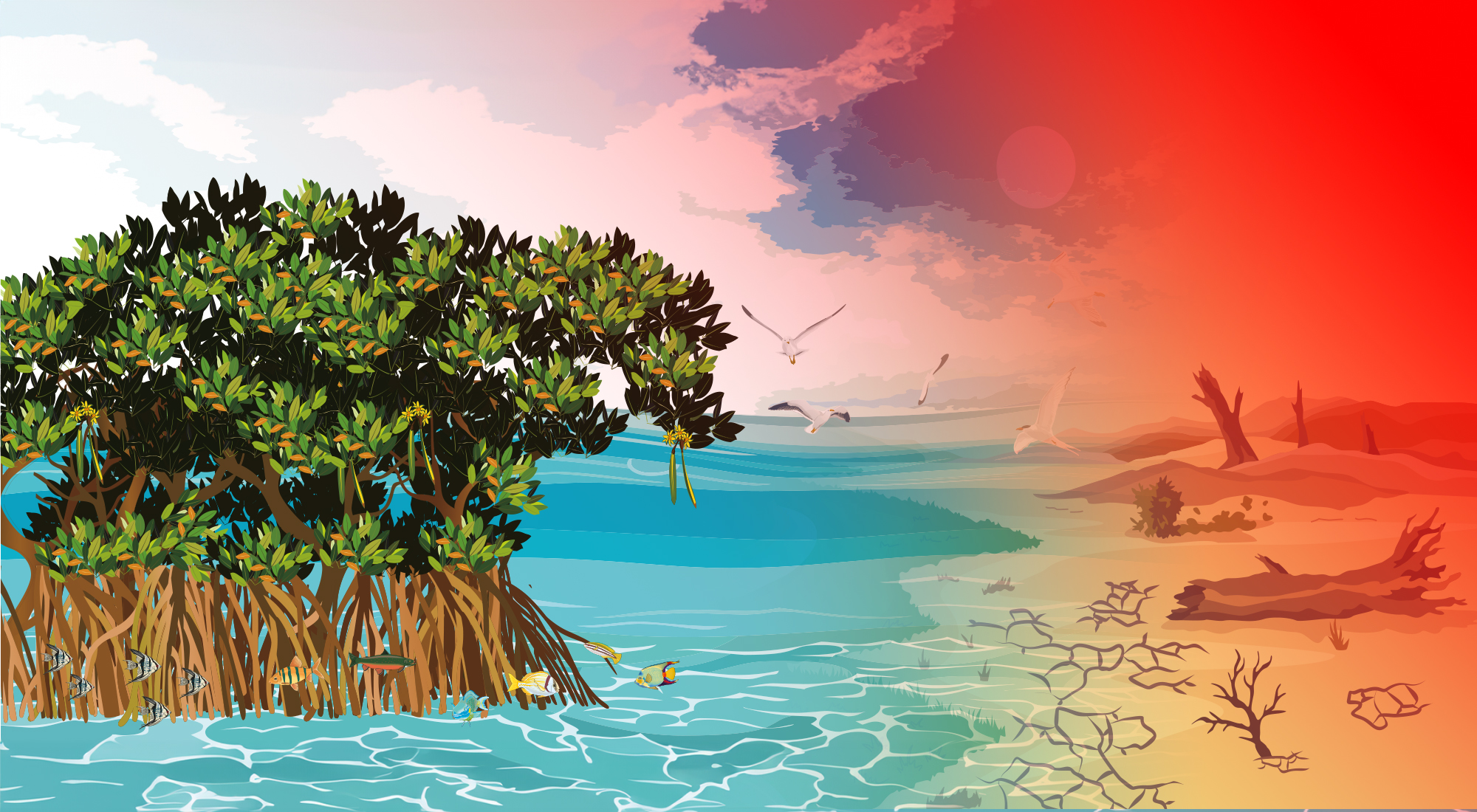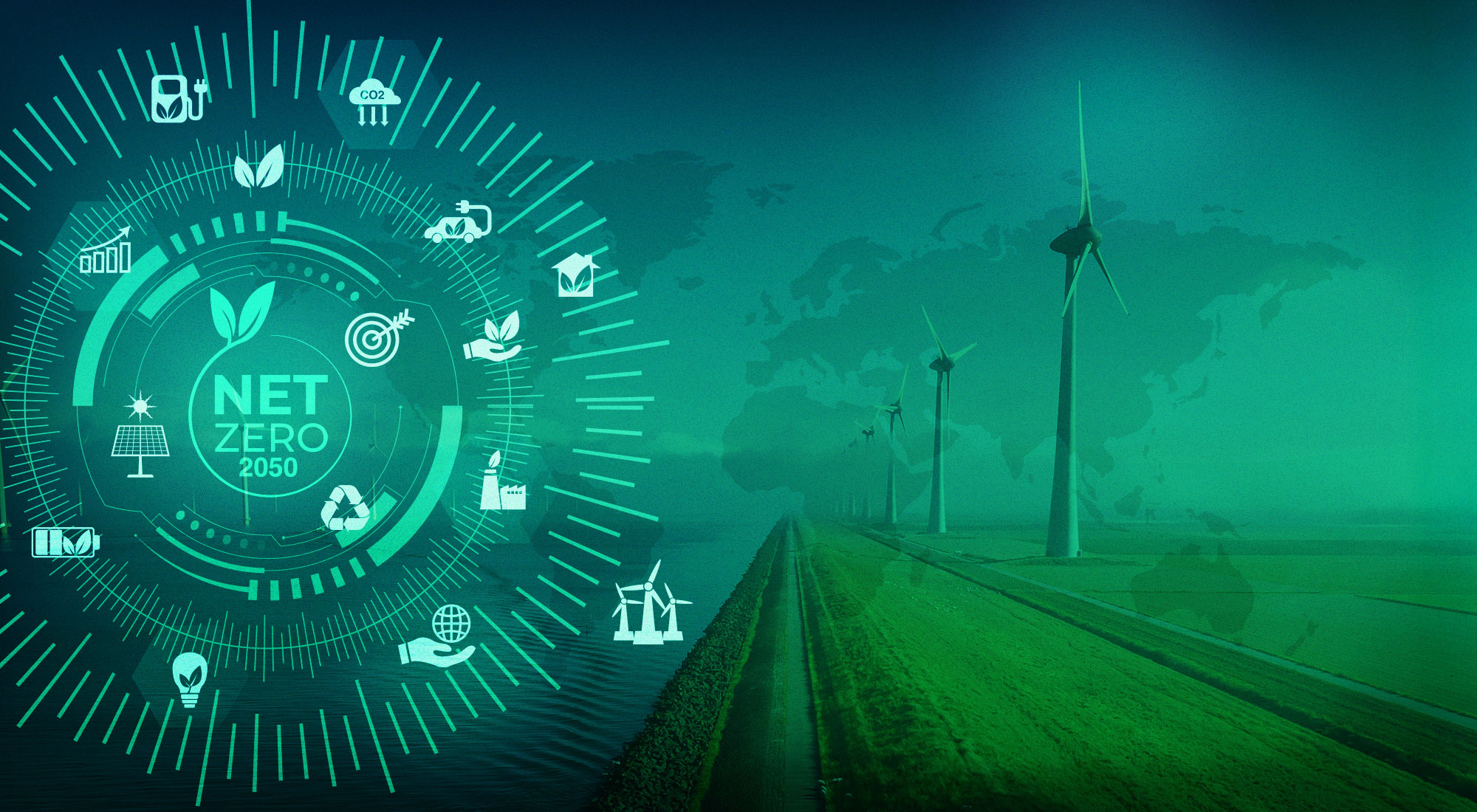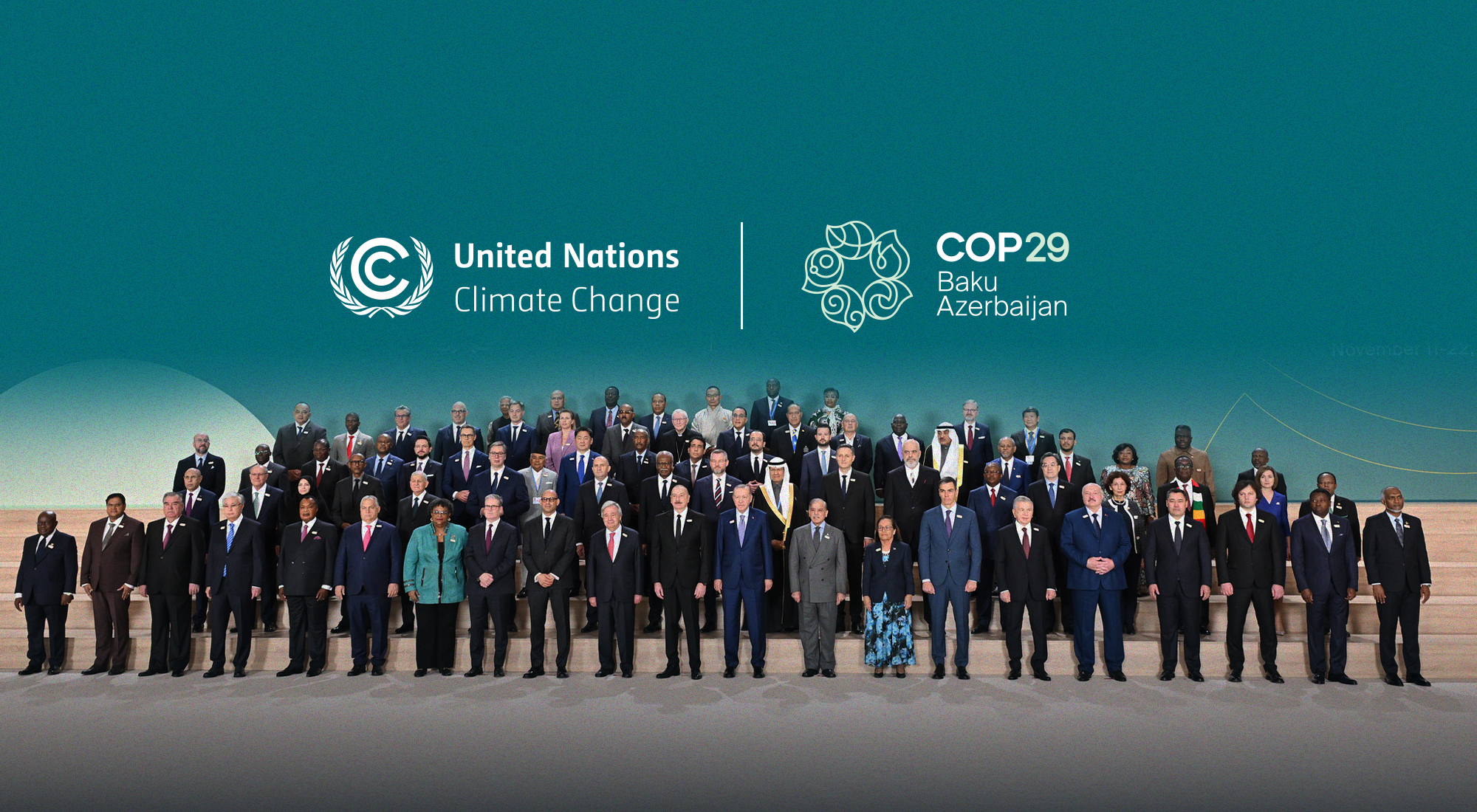Human pressures and climate change are causing biodiversity deterioration and unprecedented losses at rates never seen before. Climate change has altered marine, terrestrial, and even freshwater ecosystems, causing loss of native species, increased disease, and mass mortality of plants and animals. On land, higher temperatures have moved animals and plants to higher altitudes or latitudes. The risk of species extinction increases with each rise in temperature. In the seas, rising temperatures increase the risk of negative impacts on marine and coastal ecosystems. Coral reefs, for example, have nearly halved in the past 150 years, and increasing temperatures threaten to destroy almost all remaining coral reefs.
Due to the importance of the issue, climate change activities have been included in the work programs of the Convention on Biological Diversity. The Convention on Biological Diversity has indicated that there are important opportunities to mitigate and adapt to climate change, while promoting biodiversity conservation. It is possible to reduce the effects of climate change and the threat to ecosystems through strategies to adapt to climate change and mitigate its effects on biodiversity. Mitigation is defined as human intervention to reduce a greenhouse gas, enhance carbon sequestration or any process, activity or mechanism that removes a greenhouse gas. Examples of such activities that promote mitigation or adaptation to climate change include conserving and restoring local ecosystems, protecting and enhancing ecosystem services, managing habitats for endangered species, establishing natural reserves on land, in freshwater bodies and in the sea, and taking into account projected climate changes.
Blue carbon
Blue carbon is defined as the carbon stored in coastal and marine ecosystems such as mangroves, tidal marshes and seagrasses, which are highly productive coastal ecosystems of particular interest for their ability to store carbon within vegetation and in the sediment beneath. Scientific assessments of these systems report that they can sequester two to four times more carbon than other terrestrial forests, making them one of the most important key components of nature-based solutions to climate change.
Blue carbon and its many benefits have become one of the most discussed topics when talking about solutions and proposals on how to address climate change. The importance of blue carbon is evident in the fact that many of its projects have the enormous potential to sequester carbon and protect their ecosystems. However, most of these projects have not yet seen the light of day, prompting a debate about how much blue carbon sequestration of greenhouse gases will be on the scale we hope. On the other hand, there is one type of carbon sequestration project that offers us a glimmer of hope, because its ability to reduce carbon can be measured accurately, reliably and transparently. This type of project is the mangrove forests, which has shown its feasibility and importance in supporting ecosystems and maintaining the sustainability of local communities.
Mangroves
Mangrove is a type of tree and shrub that grows in tropical and subtropical regions around the world. The mangrove tree has a unique way of growing thanks to its thick and twisted aerial roots, which make it appear as if it is standing above the water. It looks at first glance from afar like an ordinary green tree, but when we get close to it, we see its forked roots like spider legs. Mangroves thrive in coastal tidal areas, salt water and swamps, conditions that most trees cannot tolerate. It has the ability to filter 90% of the salts in the water before it is absorbed by the roots. The salt glands present in the mangrove trees also help to excrete excess salt than they need, to form a forest between the sea and the land.
Of all the species in nature, mangroves are among the most unique and beneficial to humans. These strong trees act as a natural buffer for the wind, as they contribute to protection from sea storms and purify the surrounding waters. It also works to protect humans from tsunamis by blocking between 70% and 90% of the force of the waves. This is in addition to its prominent role in stabilizing the coasts and its ability to protect the beaches from erosion caused by currents and tides because its roots extend into the soil at a depth of up to two meters. Mangroves also have the ability to sequester and store carbon dioxide from the atmosphere, thus contributing to combating climate change.
Mangrove forests also help secure the livelihood and food security of many fishermen’s families. Approximately 4.1 million fishermen benefit from the production of billions of young fish annually in the mangrove forests. There is also a prominent role played by mangroves in the field of biodiversity, as they provide a safe and protected shelter for hundreds of birds and other marine species such as fish, shellfish, crabs and shrimp, and thus contribute to enhancing biodiversity and increasing fish stocks. Not only that, mangrove forests also protect approximately 341 threatened species worldwide thanks to their complex root system. They provide nesting, nursery and feeding grounds for many aquatic organisms, including juvenile fish of thousands of species, oysters, mussels, birds, lemon sharks and manatees. Above the ocean’s surface, the mangrove forests also provide a safe habitat for eagles, monkeys, and even tigers!
Due to the importance of mangroves, the General Conference of the United Nations Educational, Scientific and Cultural Organization (UNESCO) in 2015 adopted July 26 as the International Day for the Conservation of Mangrove Ecosystems. This day is celebrated every year to raise awareness of the importance of mangrove ecosystems and highlight their importance as a unique, distinctive and endangered ecosystem, and to promote solutions to manage these systems to ensure their sustainability and preservation.
Mangrove and its role in reducing the risks of climate change
In every single square kilometer, blue carbon ecosystems such as mangrove forests contain as much carbon as the annual emissions of 34,749 cars. This makes it one of the most important solutions in the fight against climate change. A report on the State of the World’s Mangroves 2022, issued by the Global Mangroves Alliance, indicated that ecosystems such as mangrove forests are 10 times more efficient at absorbing and storing carbon in the long term than other terrestrial ecosystems. In fact, mangroves are the most efficient carbon capture and storage system in the world. It currently stores more than 21 billion tons of carbon dioxide, which makes it one of the most important solutions in combating climate change.
In the field of reducing the damages caused by climate change, mangroves are considered a natural solution to protect against the devastation caused by tsunamis, rising sea levels, and severe storms resulting from climate change, by absorbing and dissipating the power of waves. Where a forest of mangroves can reduce the power of a sea wave by two-thirds of its capacity if it passes over a forest of mangroves for a distance of 100 meters. The Nature Conservancy reported in its Gulf of Mexico program that mangrove forests have the potential to reduce flood damage by 25.5% for properties located behind them in Collier County, Florida, USA. During Hurricane Irma that hit Florida in 2017, more than 600,000 residents noticed flooding was low in areas behind mangrove forests across the state. The report also stated that mangrove forests contributed to reducing property damage due to floods, amounting to $1.5 billion. This equates to $7,500 per hectare of mangrove forest. Some experts estimate the value of what mangrove systems can contribute to property damage reduction at more than $65 billion. This is in addition to its ability to reduce flood risks for approximately 15 million people annually.
Benefits of mangroves
There are many benefits to mangroves in addition to their benefits in the fields of biodiversity conservation, climate change mitigation and adaptation, disaster risk reduction, sustainable development, and their ability to reduce the impact of tsunamis and storms. Among the most important of these benefits are:
- Its ability to protect coasts and reduce the risk of disasters resulting from storms by absorbing and dissipating wave energy, which makes it important in preserving property and infrastructure in coastal areas and cities.
- Mangrove forests are highly productive ecosystems that possess a large biodiversity of flora and fauna, as they provide important breeding and incubation areas for fish, crustaceans and other marine species. It is also an important habitat for a variety of birds, reptiles and mammals.
- Mangroves are of great economic value. It supports a range of industries, including being a fish and crustacean fishery. It is also a source of fuelwood and charcoal for building housing in some coastal communities, in addition to its tourism uses.
- Reducing coastal erosion (e.g. soil and beach sand erosion), thus preserving the coastline from retreating.
- Mangroves are important for achieving sustainable development and reducing poverty. They provide food and income for millions of people who live in and around the mangroves, particularly in developing countries.
- Some types of mangroves have medicinal properties and are used in traditional medicine. For example, Avicennia marina has been used for treating diarrhea, dysentery and fever.
- Mangrove forests are home to many endangered species, including saltwater crocodiles, sea cows, and green sea turtles.
- Mangrove forests play an important role in circulating nutrients and maintaining water quality. They help trap and remove pollutants and excess nutrients, such as nitrogen and phosphorous, from the water.
Dangers facing mangroves
It is sad to note that mangroves face multiple threats, the most important of which are habitat destruction, climate change, and pollution. These threats will lead to the loss of mangrove forests, which in turn will greatly affect local communities, ecosystems and biodiversity. Therefore, efforts to conserve and rehabilitate these trees are important to ensure the sustainability and preservation of these valuable ecosystems. It is estimated that more than three quarters of mangroves in the world face several threats that will adversely affect their spread and thus disturb the biological balance and the survival of the organisms that depend on them.
Despite their importance, mangrove forests are still subject to a variety of human activities, including deforestation for aquaculture, agriculture, coastal development, as well as pollution and overfishing. Climate change is also a major threat, as increasing temperatures, sea level rise, changing weather patterns and extreme weather events may affect the health and distribution of mangrove forests. Because they are so vulnerable to changes in temperature and sea level, mangroves have been described as guardians of climate change. The American Museum of Natural History (AMNH) has described mangroves as “among the most threatened habitats in the world”. It also pointed out that less than half of the mangrove forests in the world were intact at the end of the twentieth century, and the remaining half were in poor condition.
There are many dangers facing mangrove forests around the world. Among the most important of these risks and causes are:
- Converting wetland areas into artificial ponds for aquaculture projects. The water is diverted away from the mangroves and the water is polluted with chemicals, antibiotics and organic waste.
- Conversion of mangrove forests for agricultural uses or tourism purposes.
- Destroying and damaging mangrove forests for coastal development of ports, docks, buildings and golf courses.
- Cutting mangrove forests by coal and wood industries.
- Climate change and the associated fluctuations in air and water temperatures, higher frequency and intensity of precipitation, ocean and sea salinity and other effects resulting from climate change.
Mangrove cultivation initiatives around the world
Some countries around the world have launched various programs to preserve and rehabilitate mangroves with the aim of ensuring the sustainability of these forests because of their important and pivotal role in preserving biodiversity and mitigating climate change. The most important of these examples are:
- The UAE is keen to take advantage of nature-based solutions to mitigate and adapt to the effects of climate change. The UAE Ministry of Climate Change and Environment announced an important step in promoting blue carbon ecosystems and employing nature-based solutions to combat climate change by launching an initiative to plant 100 million mangroves by 2030, making it one of the most important and largest global carbon sequestration initiatives.
- The Indonesian government has launched a large-scale mangrove restoration program, aiming to restore one million hectares of degraded mangroves by 2024. The program includes planting mangroves, improving management practices and involving local communities.
- In the Philippines, the Ministry of Environment and Natural Resources launched the National Mangroves Program, which aims to restore 500,000 hectares of mangrove forests until 2022. The program includes community reforestation, livelihood development, and ecotourism initiatives.
- In Thailand, the Royal Forest Department has implemented the Mangrove Restoration Program in the Gulf of Thailand, aiming to restore 100,000 hectares of degraded mangrove forest. The program includes planting mangroves, rehabilitating degraded areas, and promoting community participation.
- In Mexico, the government launched the Mangrove Restoration Program in the Yucatan Peninsula, aiming to restore 12,500 hectares of degraded mangroves. The program includes community-based reforestation, monitoring, and research initiatives.
Mangrove Alliance for Climate (MAC)
Some countries have developed plans and policies to protect and sustainably manage mangroves. These efforts include the conservation of mangroves in protected areas, restoration projects and the adoption of sustainable use practices. However, conserving and restoring mangroves can be challenging, as these ecosystems are very complex and dependent on a range of environmental factors. This requires a combination of successful conservation and restoration efforts and a multidisciplinary approach, involving scientists, policymakers, communities and other stakeholders. From this standpoint, the United Arab Emirates launched the Mangrove Alliance for Climate (MAC) in 2022 during the Conference of the Parties to the United Nations Framework Convention on Climate Change COP27, in partnership with the Republic of Indonesia. This initiative is in line with the UAE’s strategic priorities to achieve a sustainable future, to promote global climate action and to preserve biodiversity. This initiative requires concerted efforts and collaboration between governments, NGOs, communities and stakeholders.
Expanding the cultivation of mangroves is one of the most important nature-based solutions and initiatives in facing environmental challenges and absorbing and isolating greenhouse gas emissions globally, due to the ability of mangroves to absorb carbon up to four times what is absorbed by tropical forests. The initiative aims to plant and rehabilitate mangrove forests, exchange knowledge and experiences, and enhance cooperation among the participating countries. The alliance also focuses on raising awareness of climate change mitigation and adaptation methods and supporting scientific research and studies.
References
Leal, Maricé and Spalding, Mark D., The State of the World’s Mangroves 2022 (Global Mangrove Alliance, 2022), http://bitly.ws/AYUG.
Narayan, S., Thomas, C., Matthewman, J., Shepard, C.C., Geselbracht, L., Nzerem, K., Beck, M.W., “Valuing the Flood Risk Reduction Benefits of Florida’s Mangroves,” The Nature Conservancy, http://bitly.ws/LnvY.
NOAA, “Coastal Blue Carbon,” National Ocean Service, June 8, 2022, http://bitly.ws/LnCX.
UNESCO, “International Day for the Conservation of the Mangrove Ecosystem,” July 26, 2023, http://bitly.ws/LLqq.
United Nations – Climate Action. “Biodiversity – our strongest natural defense against climate change,” http://bitly.ws/LLrk.
Weeden, Meaghan, “9 Interesting Facts About Mangroves,” One Tree Planted, July 14, 2022, http://bitly.ws/LnEi.
Weiss, Jennifer. 2022. “Protecting One of the World’s Most Distinctive and Valuable Forests,” Ecosystem Marketplace, a Forest Trends Initiative, August 10, 2022, http://bitly.ws/LLsn.








